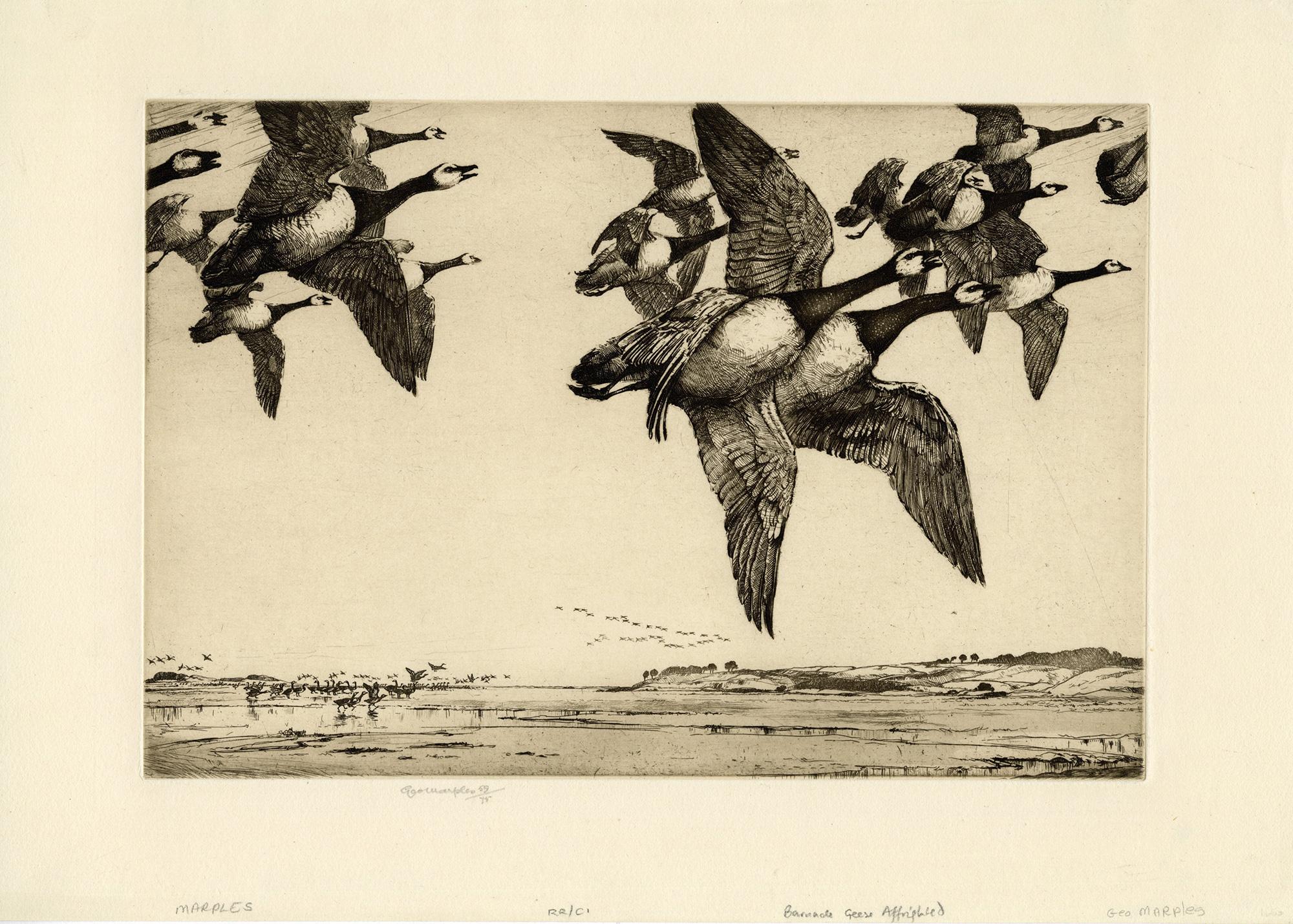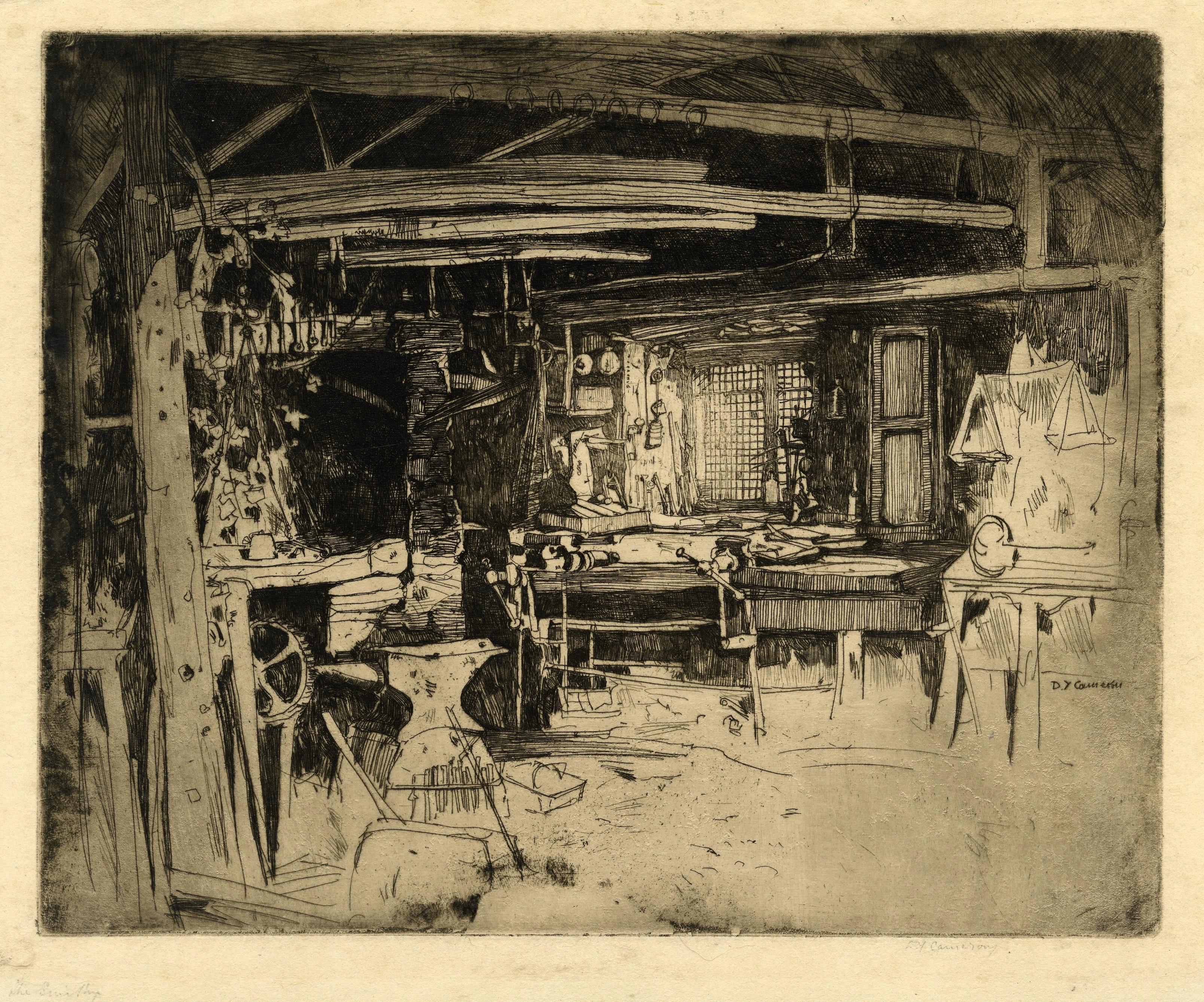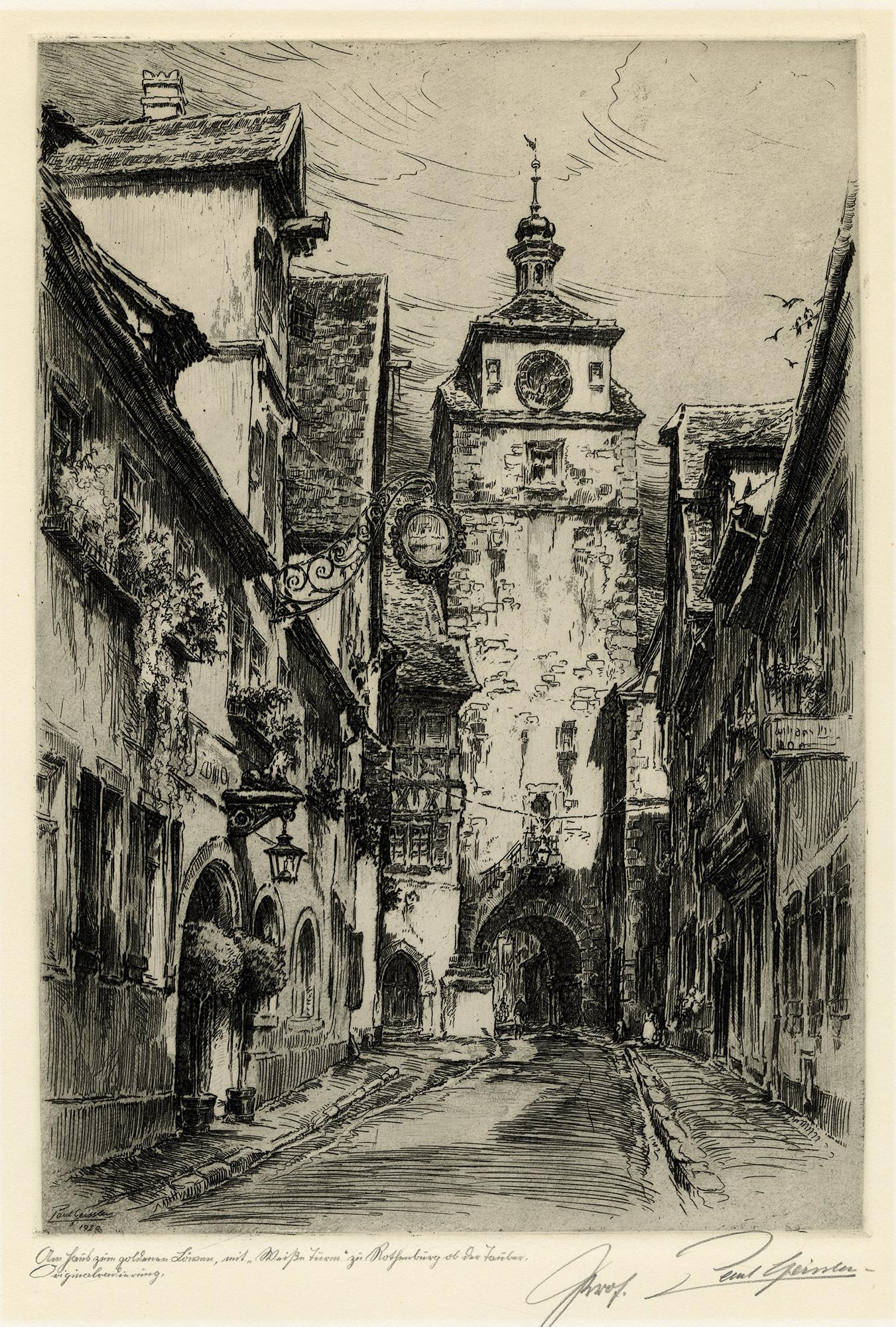Items Similar to Figures - Drypoint by Mino Maccari - 1945
Want more images or videos?
Request additional images or videos from the seller
1 of 5
Mino MaccariFigures - Drypoint by Mino Maccari - 19451945
1945
About the Item
Figures 1945 is an original drypoint realized by Mino Maccari (1945).
The artwork is in good conditions, except for worn paper on the margins. Image Dimensions: 20x18.8 cm.
Hand- signed by the artist on the lower margin, cat. Meloni no. 1756 (mm. 200x188).
Mino Maccari was an Italian writer, painter, engraver and journalist, winner the Feltrinelli Prize for painting on 1963.
For his pictorial work rich in evident chromatic accentuations and quick brushstrokes, the violent drawing combined with the living line of the graphic sign of his engravings, is recognized by the complete artist critic.
- Creator:Mino Maccari (1898 - 1989, Italian)
- Creation Year:1945
- Dimensions:Height: 11.42 in (29 cm)Width: 11.62 in (29.5 cm)Depth: 0.04 in (1 mm)
- Medium:
- Movement & Style:
- Period:
- Framing:Framing Options Available
- Condition:Insurance may be requested by customers as additional service, contact us for more information.
- Gallery Location:Roma, IT
- Reference Number:
About the Seller
4.9
Platinum Seller
These expertly vetted sellers are 1stDibs' most experienced sellers and are rated highest by our customers.
1stDibs seller since 2017
6,717 sales on 1stDibs
Typical response time: 2 hours
- ShippingRetrieving quote...Ships From: Rome, Italy
- Return PolicyA return for this item may be initiated within 14 days of delivery.
More From This SellerView All
- Figures - Drypoint by Mino Maccari - Mid-20th CenturyBy Mino MaccariLocated in Roma, ITMid-20th Century. Hand-signed in the lower right part. Numbered. Edition 1/12. Good conditions. Mino Maccari (Siena, 1924-Rome, June 16, 1989) was an Italian writer, painter, engraver and journalist, winner of the Feltrinelli Prize for Painting in 1963 and first winner of the Forte dei Marmi Satira Prize in 1973.After completing his secondary education, he enrolls in university. An interventionist like many young people of his time, he took part in the Great War at the age of nineteen as a field artillery officer. At the end of the conflict he resumed his university studies in Siena and in 1920 he graduated in law. In 1924 he was called by Angiolo Bencini to take care of the printing of the magazine Il Selvaggio, openly uncompromising fascist, revolutionary and anti-bourgeois, where his first engravings were published. After a few years of coexistence between work at the newspaper and the law firm, at the beginning of 1926 he left the legal profession to take over the direction of Il Selvaggio which he would hold until 1942. In 1928 he was the author of the small book published by Vallecchi (Florence), Il Trastullo di Strapaese (little songs and engraved woodwinds) which collected fascist songs (the same book was seized several times from Antonio Gramsci during his detention). With the transfer of the editorial staff of the Selvaggio in 1925 from Colle di Val d'Elsa to Florence, Maccari collaborated with Ardengo Soffici, Ottone Rosai and Achille Lega. In the meantime, between 1927 and 1930, he made himself known to the general public as a painter by participating in various national exhibitions. Also in 1930 Maccari works in Turin at La Stampa as editor-in-chief and has the writer Curzio Malaparte as director. His presence in the cultural and editorial world of the fascist regime is very intense, he writes and collaborates with various magazines: Quadrivio, L'Italia Letteraria, L'Italiano and Omnibus by Leo Longanesi; then, during the war, in il Primato di Bottai and, subsequently again, in Il Mondo di Pannunzio (from the first number, in 1949), up to Documento by Federigo Valli. His graphic production is also vast, ranging from the Album of Vallecchi (1925), Il trastullo di Strapaese (1928) to Linoleum (1931). Maccari illustrated in 1934 La vecchia del Bal Bullier by Antonio Baldini and in 1942 he published the Album folder, followed by Come quando fuori Piove and Il superfluo illustrata.For his pictorial work full of evident chromatic accentuations and fast brushstrokes, the violent drawing combined with the lively stroke of the graphic sign of his engravings, he is recognized by critics as a complete artist. In 1962 he was also entrusted with the presidency of the Accademia di San Luca in Rome and managed to obtain a personal exhibition at Gallery 63 in New York. His production of drawings, watercolors, temperas, etc. is endless, sometimes in collaboration with prestigious publishing houses; it is worth mentioning, just as an excellent example, the 32 b/w and color drawings with which he illustrated Il gusto di vivere, a volume that collects writings by Giancarlo Fusco, edited by Natalia Aspesi and published by Laterza in 1985. Maccari, Sienese and great contradaiolo della Torre, painted the Palio...Category
Mid-20th Century Modern Figurative Prints
MaterialsPaper, Drypoint, Etching
- Figures - Drypoint by Mino Maccari - Mid-20th CenturyBy Mino MaccariLocated in Roma, ITFigures is an Etching and Drypoint realized by Mino Maccari in the Mid-20th Century. Hand-signed in the lower right part. Numbered. Edition,3/40. Good conditions. Mino Maccari (Siena, 1924-Rome, June 16, 1989) was an Italian writer, painter, engraver and journalist, winner of the Feltrinelli Prize for Painting in 1963 and first winner of the Forte dei Marmi Satira Prize in 1973.After completing his secondary education, he enrolls in university. An interventionist like many young people of his time, he took part in the Great War at the age of nineteen as a field artillery officer. At the end of the conflict he resumed his university studies in Siena and in 1920 he graduated in law. In 1924 he was called by Angiolo Bencini to take care of the printing of the magazine Il Selvaggio, openly uncompromising fascist, revolutionary and anti-bourgeois, where his first engravings were published. After a few years of coexistence between work at the newspaper and the law firm, at the beginning of 1926 he left the legal profession to take over the direction of Il Selvaggio which he would hold until 1942. In 1928 he was the author of the small book published by Vallecchi (Florence), Il Trastullo di Strapaese (little songs and engraved woodwinds) which collected fascist songs (the same book was seized several times from Antonio Gramsci during his detention). With the transfer of the editorial staff of the Selvaggio in 1925 from Colle di Val d'Elsa to Florence, Maccari collaborated with Ardengo Soffici, Ottone Rosai and Achille Lega. In the meantime, between 1927 and 1930, he made himself known to the general public as a painter by participating in various national exhibitions. Also in 1930 Maccari works in Turin at La Stampa as editor-in-chief and has the writer Curzio Malaparte as director. His presence in the cultural and editorial world of the fascist regime is very intense, he writes and collaborates with various magazines: Quadrivio, L'Italia Letteraria, L'Italiano and Omnibus by Leo Longanesi; then, during the war, in il Primato di Bottai and, subsequently again, in Il Mondo di Pannunzio (from the first number, in 1949), up to Documento by Federigo Valli. His graphic production is also vast, ranging from the Album of Vallecchi (1925), Il trastullo di Strapaese (1928) to Linoleum (1931). Maccari illustrated in 1934 La vecchia del Bal Bullier by Antonio Baldini and in 1942 he published the Album folder, followed by Come quando fuori Piove and Il superfluo illustrata.For his pictorial work full of evident chromatic accentuations and fast brushstrokes, the violent drawing combined with the lively stroke of the graphic sign of his engravings, he is recognized by critics as a complete artist. In 1962 he was also entrusted with the presidency of the Accademia di San Luca in Rome and managed to obtain a personal exhibition at Gallery 63 in New York. His production of drawings, watercolors, temperas, etc. is endless, sometimes in collaboration with prestigious publishing houses; it is worth mentioning, just as an excellent example, the 32 b/w and color drawings with which he illustrated Il gusto di vivere, a volume that collects writings by Giancarlo Fusco, edited by Natalia Aspesi and published by Laterza in 1985. Maccari, Sienese and great contradaiolo della Torre, painted the Palio...Category
Mid-20th Century Modern Figurative Prints
MaterialsPaper, Drypoint, Etching
- Figures - Drypoint by Mino Maccari - Mid-20th CenturyBy Mino MaccariLocated in Roma, ITFigures is an Etching and Drypoint realized by Mino Maccari in the Mid-20th Century. Hand-signed in the lower right part. Good conditions. Mino Maccari (Siena, 1924-Rome, June ...Category
Mid-20th Century Modern Figurative Prints
MaterialsPaper, Drypoint, Etching
- Erotic Scene - Etching by Mino Maccari - Mid-20th CenturyBy Mino MaccariLocated in Roma, ITErotic Scene is an Etching and Drypoint realized by Mino Maccari in the Mid-20th Century. Hand-signed in the lower part. Good conditions. Mino Maccari (Siena, 1924-Rome, June 16, ...Category
Mid-20th Century Modern Figurative Prints
MaterialsPaper, Etching, Drypoint
- Erotic Scene - Etching by Mino Maccari - Mid-20th CenturyBy Mino MaccariLocated in Roma, ITErotic Scene is an Etching and Drypoint realized by Mino Maccari in the Mid-20th Century. Hand-signed in the lower part. Good conditions. Mino Maccari (Siena, 1924-Rome, June 1...Category
Mid-20th Century Modern Figurative Prints
MaterialsPaper, Drypoint, Etching
- Erotic Scene - Etching by Mino Maccari - Mid-20th CenturyBy Mino MaccariLocated in Roma, ITErotic Scene is an Etching and Drypoint realized by Mino Maccari in the Mid-20th Century. Hand-signed in the lower part. Good conditions. Mino Maccari (Siena, 1924-Rome, June 1...Category
Mid-20th Century Modern Figurative Prints
MaterialsDrypoint, Paper, Etching
You May Also Like
- L'Etreinte. II (Embrace)By (after) Pablo PicassoLocated in Palo Alto, CACreated in 1933, this Etching with Drypoint on Montval laid paper is stamped by the Picasso Estate Collection via Marina Picasso on verso and is a rare proof, aside from the numbered...Category
1930s Modern Figurative Prints
MaterialsLaid Paper, Drypoint, Etching
- Barnacle Geese AffrightedLocated in Middletown, NYEtching and drypoint on cream wove paper, full margins. Signed and numbered 59/75 in pencil, lower margin. Notations in pencil along the lower sheet edge, recto, well outside of ima...Category
Mid-20th Century Modern Animal Prints
MaterialsHandmade Paper, Drypoint, Etching
- The SmithyBy Sir David Young Cameron, R.A.Located in Middletown, NYA warm composition, in theme and tone; the creaky timber interior of a 19th century Scottish blacksmith's shop. Etching and drypoint on cream laid Japan paper, 8 x 10 inches (202 x ...Category
Late 20th Century Modern Interior Prints
MaterialsLaid Paper, Drypoint, Etching
- The Acropolis, AthensBy Louis Conrad RosenbergLocated in Middletown, NYEtching and drypoint on cream wove paper, full margins. Signed in pencil, lower right margin. In generally good conditon with several scattered very light spots of foxing throughout,...Category
1920s Modern Landscape Prints
MaterialsHandmade Paper, Drypoint, Etching
- Market Square, Rothenburg, GermanyLocated in Middletown, NYEtching and drypoint on cream wove paper, 10 3/4 x 7 1/2 inches (270 x 190 mm), full margins. Signed, inscribed and titled in pencil, lower margin. In good condition with minor mat t...Category
Early 20th Century Modern Landscape Prints
MaterialsHandmade Paper, Drypoint, Etching
- The Berry PickersLocated in Middletown, NYDrypoint etching on cream laid paper with an oak leaf watermark, c 1935. 7 1/4 x 9 3/4 inches (183 x 241 mm), full margins. Signed, titled and inscribed in pencil, lower margin. A b...Category
Mid-20th Century American Modern Figurative Prints
MaterialsLaid Paper, Drypoint, Etching
Recently Viewed
View AllMore Ways To Browse
Vintage Cat Figures
Paul Durand
New Chanel Watch
Nude Sketch Of A Woman
Pablo Picasso Signed Ceramic
Avant Arte
Sacred Window
Gallery Announcement
Flat Apartment
Dali Face
Deco Pochoir
Renaissance Dress Vintage
Picasso 150
Original Vintage Jazz Posters
Vintage Winter Hat
From Russia With Love Poster
Amedeo Modigliani Signed
Paris Royale





